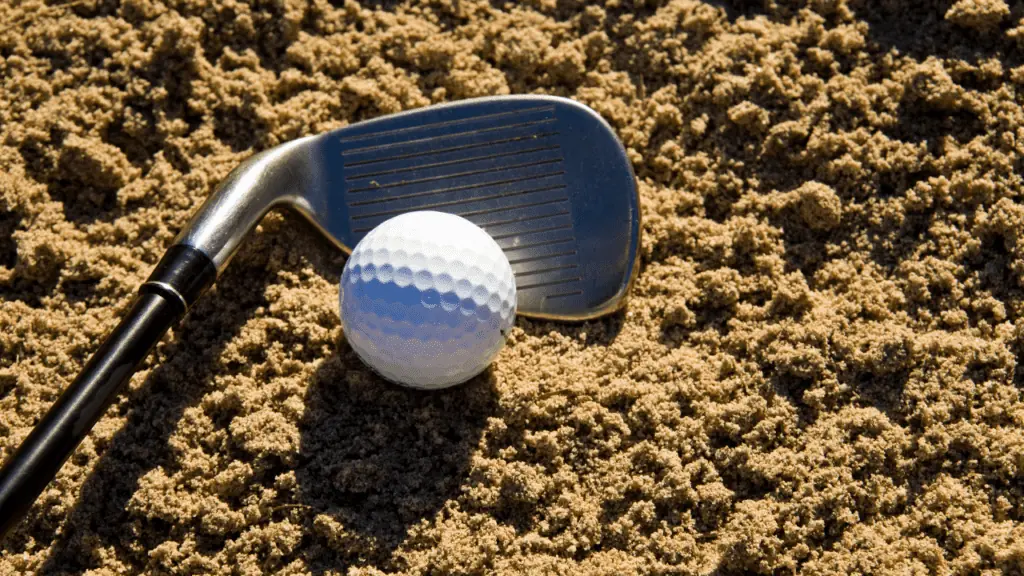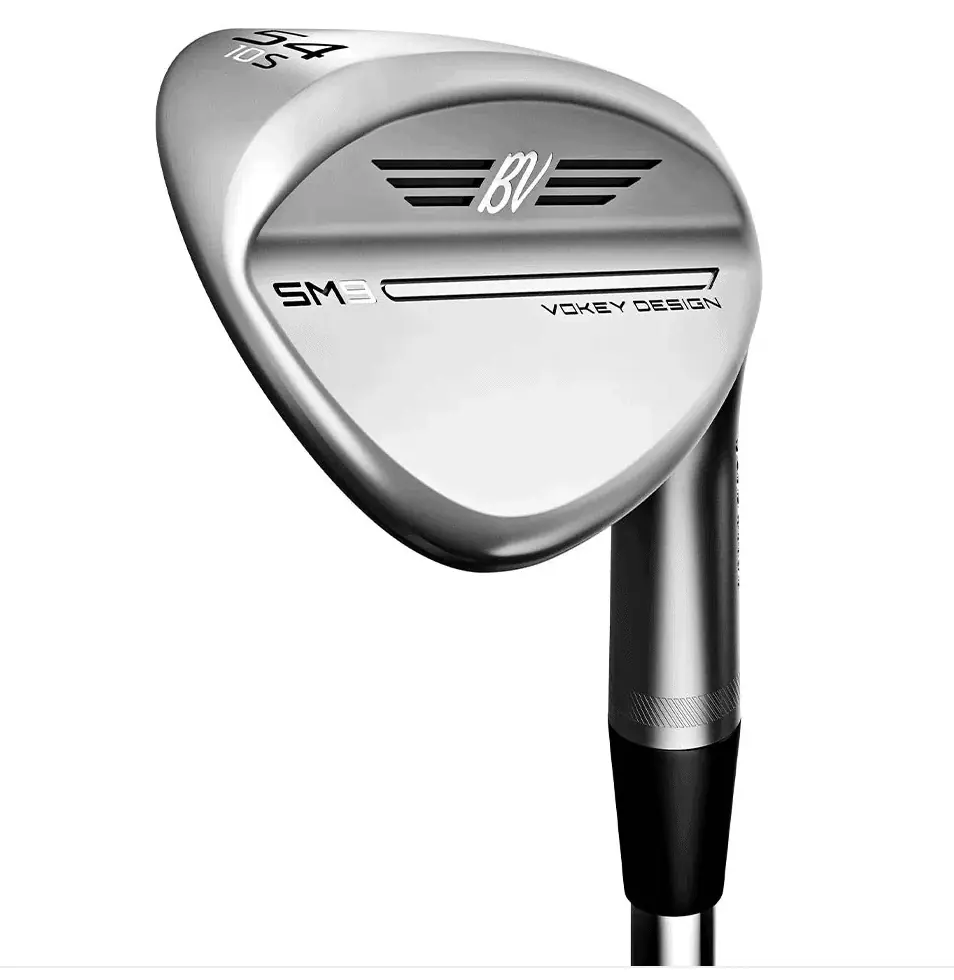Table of Contents
Understanding golf wedge degrees can seem complex especially when it comes to chip shots, flop shots, and bunker shots. Read on for common questions answered.
Golf wedges are complex golf clubs crafted in several lofts, lies, and sole grinds. This can fluster beginners, so I will make it easy and take you through one step at a time. Today, I focus on golf wedge degrees and explain which build works best for chip, flop, and bunker shots.
In addition, I will introduce you to wedge bounce and how you can choose the best option for your needs.
By the end of this article, you will know the difference between a 46 and 60 degree wedge, plus when to swing it.
⛳️ Read Next: 11 Best Golf Wedges to Shave Off Strokes
What Degree is a Pitching Wedge?
My first set of irons featured a 46-degree pitching wedge, but times have changed, and manufacturers have strengthened the loft. These days you find pitching wedges as strong as 41 degrees which would have passed as a 9 iron in my junior years.
The new Callaway Paradym X Pitching Wedge is case and point, carrying 41 degrees. In addition, the Cobra LTDx possesses at 41.5 degrees, while the TaylorMade Stealth Iron Set is at 43 degrees.
However, those are game improvement irons designed to help you hit further. When we look at players’ irons, we see that designs such as the TaylorMade P770 pitching wedge still contain 46 degrees of loft.
What Degree is a Gap Wedge?
Wedge manufacturers build stock gap wedges with 50 or 52 degrees of loft to bridge the gap between your pitch and sand wedge. Unlike a pitching wedge, the loft profiles are clear and consistent and only differ on custom-crafted wedges.
Golf Wedge Degrees: 50 vs 52 Degree Wedge
A 50 degree gap wedge is the strongest lofted gap wedge option after a pitching wedge. Conversely, a 52 degree wedge is the weakest lofted gap wedge. The loft of your pitching wedge is a great approach to identifying your preferred gap wedge setup.
If you swing a 43 degree pitching wedge, I recommend the 50 degree gap wedge to avoid any gaps between the two clubs. On the contrary, a 52 degree wedge works for golfers playing a 45 or 46 degree pitching.
What Degree is a Sand Wedge?
The two predominant sand wedge loft degrees are a 54 and 56 club. In my case, I swing the weaker 56-degree design as I prefer the added spin, launch, and versatility. Where it gets murky is the 58 degrees.
In my earlier days, I swung a 58-degree sand wedge because I did not use a lob wedge back then. However, most brands, including Titleist Vokey, market their 58-degree golf clubs as lob wedges. In this sector, what Bob Vokey says, goes.
What Degree is a Lob Wedge?
Following on from my previous comment, lob wedges start at 58 degrees and extend up to 62 degrees in most cases. Certain wedge sets like the Cleveland CBX Full Face include lob wedges as weak as 64 degrees. However, in my experience, the average golfer finds this loft too challenging to control.
The most popular lob wedge setup is a 60-degree design which helps you execute flop shots, chip shots, bunker shots, and pitch shots.
What is Wedge Bounce?
Wedge bounce dictates the degree that the sole of a wedge will bounce off the turf to prevent the clubhead from digging into the earth.
According to Titleist Vokey, the bounce degrees of wedges typically range from 4 on the low side to over 10 on the high side.
The lower the degrees are, the less bounce the sole delivers, making it ideal for conditions where you do not require the added spring off the turf. These builds are designed for golfers who take minimal divots or operate firmer turf conditions and typically range from 4 to 6 degrees of bounce.
Mid-bounce wedges range from 7 to 10 degrees and suit an array of golfers looking to play an arsenal of shots around the green.
In my experience, these golf wedges provide the right amount of spring off the turf to stop you from chunking your shot but insufficient to bounce over your golf ball.
The final option is a high wedge bounce grind that exceeds 10 degrees. These wedge grinds are designed for golfers with steep attack angles and soft turf conditions. The added bounce on the wedge prompts it to lift from the turf, preventing the leading edge from burying in the ground.
Read Next: Chipper Vs Wedge: Critical Differences Golfers Must Know
What Wedge Degree is Best For Pitch Shots?
Depending on your distance from the pin and the surrounding conditions, you can use any wedge to play a pitch shot. However, I prefer sticking to the lower loft of a 52 degree gap wedge and a 56 degree sand wedge for an additional release after landing.
However, if I have some ground to cover, I will use my pitching wedge for the lower launch, roll, and reduced spin.
Golf Wedge Degrees: 52 vs 56 Degree Wedge
The reason I choose a 52 degree gap wedge boils down to reduced loft and added control. Sometimes my 56 degree sand wedge can get under the ball and sky my shot preventing it from reaching the cup.
What Wedge Loft is Best For Full Shots?
Like pitch shots, it depends on how far you are from the flag, but I like to avoid hitting full shots with anything weaker than a 56 degree or sand wedge. The moment I swing a weaker loft, my golf ball balloons and loses distance and control.
However, your pitching and gap wedge is best equipped for full shots as their soles are crafted for complete strikes.
Which Wedge Loft Should I Use For Bump and Runs?
My go-to for bump and runs is my 46 degree pitching wedge. The longer shaft and lower loft make it conducive to keeping my ball low and running it up to the cup.
The shorter the shaft and weaker the loft is, the more difficult it becomes to remain upright posture and keep your ball low.
⛳️ Read Next: Most Forgiving Wedges to Enhance Your Short Game
Which Wedge Degree Should I Use For Chip Shots?
A 54 or 56 degree sand wedge is the ideal club for chip shots. It gives you a lower loft and high spinning grooves for improved control. In addition, a sand wedge possesses a versatile sole that helps you get under the ball from the sand, rough and tight lies.
However, I also use my 60 degree wedge when I require less run and a higher launch to attack the flag from the green side.
What Is The Best Golf Wedge Loft For Bunker Shots?

In my experience, a 54 or 56 degree sand wedge is best for bunker shots as it is constructed for the purpose. Your sand wedge helps the sole glide across the bunker without digging into the sand, prompting a clean strike and an escape from the bunker.
Alternatively, you could take a leave out of my book and hit a few bunker shots with your lob wedge. However, the lack of forgiveness and higher loft renders it a difficult challenge for the average golfer.
What Is The Best Golf Wedge Degree For Flop Shots?
My prized 60-degree loft wedge is my recommended tool for flop shots. The weaker loft, precise sole, and enhanced grooves simplify opening my clubface, getting under the golf ball, and launching it high.
Bear in mind that a low-bounce lob wedge is recommended for flop shots. A high-bounce wedge can cause your clubface to bounce into a higher part of the ball, preventing you from getting under it and launching it.
⛳️ Read Next: 20 Best Golf Training Aids [Golf Expert Review]
Final Thoughts on Golf Wedge Degrees
Now that you have a clearer picture of golf wedge degrees and which is best for different shots, what will it be? Are you inclined to add a weak lofted 60 degree lob wedge to your bag? Or is a 56 degree sand wedge sufficient for chips, flops, bunker shots, and full shots?
In addition, if you currently operate with a pitching and sand wedge and suffer distance gaps, I recommend testing a gap wedge.
The 50 degree and 52 degree wedges eradicate holes in your game and give you an extra chipping, pitching, and full-shot club. Check out my article on the best golf wedges for a in-depth review of ideal golf clubs for seniors.
Finally, you must factor your desired wedge bounce into the equation for optimal results off the turf. If you have a shallow swing and play on firm turf, then a low bounce wedge is the way to go. Conversely, steep attack angles require, and soft ground is best equipped for a high-bounce grind.
Finally, the average golfer with a moderate attack angle should stick to mid-bounce wedges. Overall, there must be no gaps in your wedge game, and you enjoy maximum control on chips, flops, pitch shots, and bunker shots.



